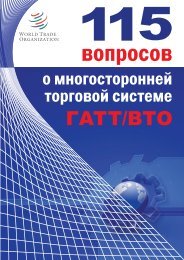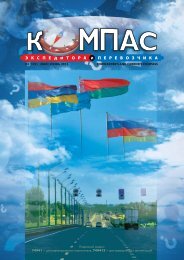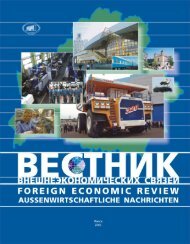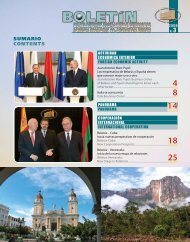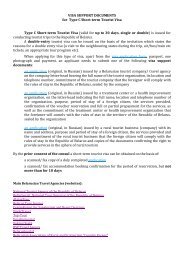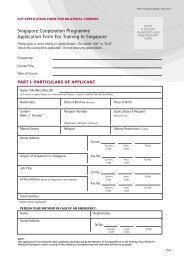Human Development Report 2013 - UNDP
Human Development Report 2013 - UNDP
Human Development Report 2013 - UNDP
Create successful ePaper yourself
Turn your PDF publications into a flip-book with our unique Google optimized e-Paper software.
BOX 3.5Eastern Europe and Central Asia: where North meets SouthConnecting the North and the rising South is the transforming East. EasternEurope and Central Asia accounts for 5% of world population and output. Itsexperience in managing a rapid transition from centrally planned to marketeconomies holds useful policy lessons for developing countries elsewhere.The first phase of the transformation began with a sharp drop in living standardsand human development. While each country managed a subsequentrecovery under varying political and economic conditions, the overall experienceunderscores the importance of social inclusion and a responsible roleof the state.The 2011 Regional <strong>Human</strong> <strong>Development</strong> <strong>Report</strong> for Europe and theCommonwealth of Independent States showed a negative correlation between<strong>Human</strong> <strong>Development</strong> Index values and measures of social exclusionin Eastern Europe and Central Asia. It noted that economic variables accountedfor less than a third of the risks contributing to individual exclusion.Labour informality, corruption and lengthy procedures for businessstartups were associated with high social exclusion. By contrast, becauseemployment facilitates inclusion, functional and accessible labour marketinstitutions were found to be important. A major lesson from two decadesof transition is that the state has a critical role in creating an environmentfor inclusive growth and societies. Abruptly abandoning areas of responsibilityby the state or insisting on rapid privatization of all state-ownedcompanies may prove very costly for societies in the long run. Yet at thesame time, retaining these responsibilities does not mean keeping theearlier structures intact. On the contrary, reforms to strengthen nationalinstitutions’ transparency and accountability and to limit the scope of corruptionare necessary to improve the quality of governance and efficiencyof governments.Many countries of the region are now active members of the EuropeanUnion. They, together with Croatia, Kazakhstan, the Russian Federationand Turkey, have also become emerging donors, with aid disbursementsexceeding $4 billion in 2011. The emerging donors are also active in bilateralor trilateral exchange of knowledge with countries with commonheritage or beyond. In recent years Romania has shared its experienceconducting elections with Egypt and Tunisia, Poland has helped Iraqwith small and medium- size enterprise development, the Czech Republichas cooperated with Azerbaijan on environmental impact assessmentsand Slovakia has assisted Moldova and Montenegro in public financemanagement.Source: HDRO; <strong>UNDP</strong> 2011b.A dynamic view ofcomparative advantagehas enabled severalcountries to turninefficient industriesunable to withstandforeign competition intodrivers of export successonce their economiesbecame more open• India. India increased central governmentspending on social services and rural developmentfrom 13.4% in 2006–2007 to 18.5%in 2011–2012. 21 And social services as a proportionof total expenditure rose from 21.6%in 2006–2007 to 24.1% in 2009–2010 andto 25% in 2011–2012.Nurturing selected industriesGovernments can encourage a marketdisciplinedprivate sector by adopting adynamic view of comparative advantage,nurturing sectors that would not otherwiseemerge due to incomplete markets. 22 Althoughthis poses some political risks of rent seekingand cronyism, it has enabled several countriesof the South to turn industries previouslyderided as inefficient and unable to withstandforeign competition into early drivers ofexport success once their economies becamemore open.• India. For decades after independence in1947, India followed a strategy of stateled,import-substituting industrialization.It inhibited the private sector while bestowingwide powers on technocrats whocontrolled trade and investment, creatinga system that became increasingly ladenwith bureaucratic intricacies (the “licenceRaj”). 23 During these years, however, therewas a deliberate policy to build humancapabilities and invest in world-class tertiaryeducation, though perhaps neglectingprimary education. Following the reformsof the 1990s, these investments paid offwhen India was unexpectedly able tocapitalize on its stock of skilled workersin emergent information technology–enabledindustries, which by 2011–2012were generating $70 billion in export earnings.Another industry built during theinward-looking years is pharmaceuticals.India granted patents only to processes,not to products, which encouraged firms toreverse engineer and become world leadersin generic drugs. 24 Similar tales of capacitybuilding can be told for India’s automobile,chemical and service industries, now vigorouslytapping into world markets.• Brazil. For long stretches, Brazil also experimentedwith inward-oriented economicstrategies. During these periods, individualfirms that benefited from large domestic70 | HUMAN DEVELOPMENT REPORT <strong>2013</strong>




